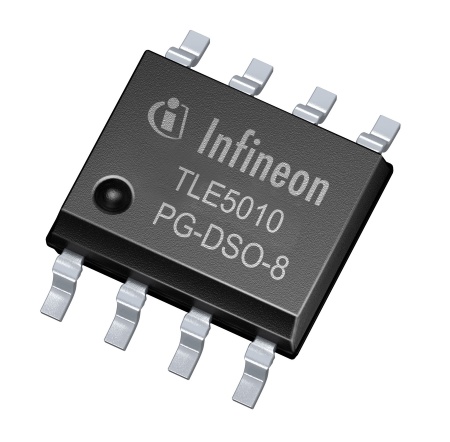Infineon Incorporates Nobel Prize-Winning Technology into its Sensors
Neubiberg, Germany – December 20, 2007 – This year’s Nobel Prize for Physics was awarded to the discoverers of the giant magneto resistance effect. Infineon has begun using this effect to measure steering angle in automobiles and is the world’s first semiconductor supplier to begin volume manufacturing of an integrated giant magneto resistance sensor (iGMR). The Infineon sensor, which is capable of measuring angles from 0° to 360° with exceptional precision, incorporates two GMR full bridges, a temperature sensor, two analog/digital converters, several voltage regulators, additional filters, and internal mechanisms for continuously monitoring these components during operation.
The Infineon sensor chip, the TLE 5010, provides two digital angle components – a sine function and a cosine function. An 8-bit microcontroller connected to the sensor over an SPI interface uses these to compute an exact angle signal. Transferring data digitally between the sensor and microcontroller means lower susceptibility to interference, and the integrated temperature sensor is used for the compensation to ensure high angle precision across a wide temperature range from -40 °C to +150 °C.
The GMR effect is based on a change in resistance produced by a magnetic field in a multilayered metal film several nanometers thick. Put simply, the film consists of a reference layer with a fixed, stable direction of magnetization (the reference direction) and a sensor layer whose magnetization follows an externally applied magnetic field, like a the needle of a compass. The sensor layer and reference layer are separated by a layer of copper just a few atoms thick, which produces the GMR effect. The electrical resistance of this type of film changes according to the angle between the magnetic field applied and the sensor’s reference layer. Infineon has succeeded in incorporating layers of this kind with the requisite degree of precision into the standard CMOS production process for semiconductors.
“When it comes to innovative, highly integrated sensors, Infineon has made outstanding technological achievements. We are using the GMR effect in magnetic field sensors in automobiles to greatly increase precision,” says Frank Bauche, Senior Director, Marketing for sensors at Infineon. “We are working to develop increasingly intelligent sensors that help to improve automobile safety, increase fuel efficiency and reduce emissions.”
Infineon ranks first in automotive safety sensors
By its own estimates, Infineon leads the world with its sensor chips in a range of automotive safety applications. The company is the number-one supplier of pressure sensors used in tire pressure monitoring systems (TPMS), with a market share of more than 50 percent; it also has a share of around 50 percent of the market for Hall effect sensors used to measure wheel rotation speeds in antilock braking systems; and it commands a share in excess of 80 percent in the market for fully integrated pressure sensors for side-impact airbag systems.
Statistically, every new automobile manufactured worldwide today contains roughly two dozen chips from Infineon, and every new vehicle has five Infineon sensors, on average – in antilock braking and side airbag systems, for example. In addition, one in four new cars is fitted with airbag sensors from Infineon.
Infineon today is one of just a few semiconductor suppliers that work in all three major sensor segments (pressure, magnetic and acceleration sensing) and is able to offer sensor chips for automotive safety, powertrain, body and convenience electronics.
The 2007 Nobel Prize for Physics for the discovery of the GMR effect
The Nobel Prize for Physics in 2007 was awarded to Peter Gruenberg from the Helmholtz Research Centre in Juelich, Germany, and to Albert Fert, a professor at the University of Paris-Sud, France. The two engaged in research into giant magneto resistance (GMR) independently of one another in the eighties. They were honored with the Nobel Prize for their discovery of the giant magneto resistance effect, through which external magnetic fields can produce a large change in the electrical resistance of thin layers of magnetic material. The discovery of the GMR effect paved the way for the development of new read-out heads in compact computer hard drives that enabled the storage capacity of the drives in personal computers, portable music players (MP3 players) and video recorders to increase into the multiple gigabyte range.
Further information on Infineon’s sensors at www.infineon.com/sensors
About Infineon
Infineon Technologies AG, Neubiberg, Germany, offers semiconductor and system solutions addressing three central challenges to modern society: energy efficiency, communications, and security. In the 2007 fiscal year (ending September), the company reported sales of Euro 7.7 billion (including Qimonda sales of Euro 3.6 billion) with approximately 43,000 employees worldwide (including approximately 13,500 Qimonda employees). With a global presence, Infineon operates through its subsidiaries in the U.S. from Milpitas, CA, in the Asia-Pacific region from Singapore, and in Japan from Tokyo. Infineon is listed on the Frankfurt Stock Exchange and on the New York Stock Exchange (ticker symbol: IFX).
Information Number
INFAIM200712.027
Press Photos
-
 The sensor chip TLE 5010 is used to measure steering angle in automobiles and is capable of measuring angles from 0° to 360° with exceptional precision.TLE5010
The sensor chip TLE 5010 is used to measure steering angle in automobiles and is capable of measuring angles from 0° to 360° with exceptional precision.TLE5010JPG | 786 kb | 2346 x 2305 px
